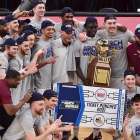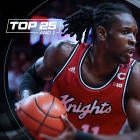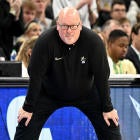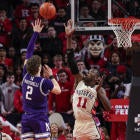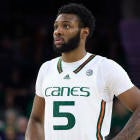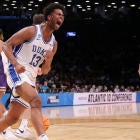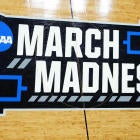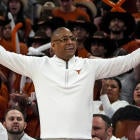
When NCAA Tournament teams descend upon Indianapolis in the coming days, all 34 people in a team's traveling party will be handed a tile-shaped white rectangle.
That piece of tech may be what keeps the 2021 NCAA Tournament from chaos. The NCAA hopes these white rectangles can help prevent a Duke-type elimination situation from surfacing in Indianapolis.
The tile, made by Kinexon and slightly larger than a domino, is a device known as a "SafeTag." When players, coaches, associate athletic directors -- anyone in a travel party -- receives their SafeTags, they'll be linked with a unique ID number that will be uploaded to Kinexon's exposure management software. Only local health officials and team doctors will have the information.
Kinexon's devices are in part what made the NBA bubble possible, and now they're the security blanket to a more-reliable NCAA Tournament.
The company was founded in 2012 in Munich, Germany. Kinexon was (and still is) used to help athletes with training regimens and rehabilitation. The technology is coveted in this era of hyper-elite fitness, where all data is wanted data.
When the pandemic set in, Kinexon's sensor technology became indispensable to the uncommon enterprises trying to safely do things that required dozens if not hundreds of people. Last year the company introduced what it calls "SafeZone," which was tech modified to reprogram its wearable devices to measure distance and duration between sensors in the devices. It was an objective, data-driven way to institute physical distancing and assist in crucial, accurate contact tracing.
Kinexon has expanded to more than 300 teams and leagues in the past 10 months, including the ACC, Big 12, SEC, Pac-12, Missouri Valley and CAA.
What the SafeTag isn't: a tracking device. There is no GPS technology or anything that monitors location and movement. The tiles communicate with only each other and no larger infrastructure is involved.
"Unlike our performance wearables, this device is incapable of tracking location," Kinexon spokesperson Matt Bontorin said. "The device measures the distance and duration from other devices, then logs those contacts for contact tracing purposes. Location is not involved in this measurement."
Players and coaches will be required to wear SafeTags when together for team activities, which includes traveling to and from practices and games, in addition to every minute during those practices and games. The NCAA is not mandating Tier 1 personnel wear their SafeTags at any other point.
"The (selection) committee and staff didn't think it was appropriate to be monitoring young men and women 24 hours a day," NCAA vice president of basketball Dan Gavitt said Wednesday. "They're responsible adults that can make decisions on their own. You always look at what the unintended consequences are of a decision. The criticism that could come, the discomfort from student-athletes of being essentially monitored 24 hours a day when they're in their hotel rooms by themselves studying or sleeping or resting, was not something the committee or staff were comfortable with."
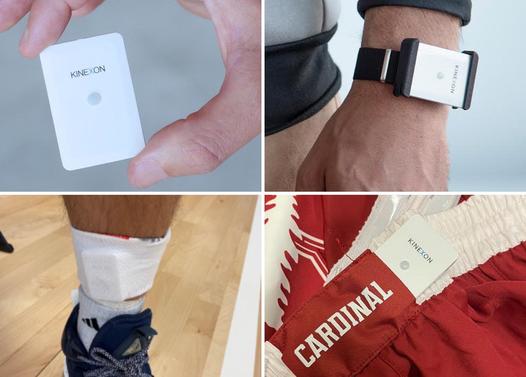
The SafeTags can be worn in multiple ways: via sewn patches on uniforms, inside socks, as a bracelet, inside a lanyard. Team trainers will most likely be the ones responsible for distributing and retrieving them every day. The battery life lasts about 12 hours and requires 90 minutes to recharge. The NCAA ordered approximately 5,700 SafeTag devices for both its men's and women's NCAA Tournaments, and it's expected that more than half the teams involved will be familiar with the SafeTags, as they've been using them for most of if not the entire season. The company said it runs just under $10,000 for one school to use the tech for one season. The NCAA is paying well into the six figures to utilize Kinexon to keep the tournament as practically safe as possible.
The SafeTags are rugged, with resistance to sweat and water (without prolonged submission). If someone loses or breaks one? Kinexon has provided enough SafeTags to have as backup. As for the constant data-collecting process the tiles use, the technology is called ultra-wideband (UWB), which the company claims has "centimeter-accurate precision."
"Compared to other technology, which is accurate within one or two feet, SafeZone has an advanced level of reliability when performing contact tracing," Kinexon executive vice president Jim Garofalo said. "When the SafeTags are returned to their charging pads, the data is uploaded to the Kinexon exposure management platform. Kinexon does not have access to this data. Only designated medical officials have access. In the case of a positive infection, designated medical officials can easily identify how long an individual was exposed to someone and how close they were to that person."
User privacy is paramount, so movement won't be tracked.
"The solution does not identify where a user is, only who that user has been in contact with and for how long," Garofalo said. "If there is a positive test, designated team medical officials and local health departments review the data to determine who has had 'high-risk' close contacts and who needs to be quarantined."
As for exposure risks, the tournament will still have its challenges. If someone on a team pops positive, anyone with more than 15 minutes of combined exposure would be put in quarantine. While Tier 1 personnel will only be wearing the devices during collective team activities, it's downtime during games that pose the biggest threat. Due to the number of TV timeouts, if a team opts to continue to have compact huddles, that cumulative exposure could prove detrimental to a team's eligibility should a player or two test positive soon thereafter.
Between locker room fraternizing and 10 or more timeout huddles over a two-hour period, that is easily north of 30 minutes of close contact unless a team chooses to get creative with its spacing.
"Timeouts are a challenge," Gavitt said when I asked him Wednesday. "Coaches are going to have to be creative as they have been throughout the regular season to keep spacing, to not have players stand next to each other during every timeout and huddle. The reality is it is what it is in terms of the close contact. So whether we use Kinexon or not, we'll have video that will show close contact just as much as Kinexon will potentially. I think Kinexon will help us in many ways to definitively determine, really in most cases, that there's not close contact among players. But it is going to require some level of discipline and creativity to avoid those situations."
Typically, the devices do flash a red warning signal -- and can also make a noise -- when someone is within six feet of another person, but the NCAA will disable those features because they could be distracting during competition. Mask-wearing and distance mindfulness can take people only so far. The NCAA was seeking a data-based arbiter to help keep its tournament safer and ethically on the up-and-up. The SafeTags help make that a reality.
"We've seen consistently throughout the season that our technology has helped programs avoid shutting down," Garofalo said. "It's reduced the spread of an outbreak, thus allowing games to be played, not canceled. Throughout the season teams have been encouraged to utilize the data in ways that allows them to readjust operationally. If they are noticing that certain individuals are consistently in contact for long periods of time, it would make sense for them to make adjustments. For example, while the technology can't determine location, if players who sit next to each in the locker room are piling up minutes of contact, it may be time to rethink the distancing in the locker room. This can be applied to many different environments and situations. The device can be a learning and preventative tool as much as a reporting tool."
Loyola Chicago to test committee's seeding ideology
I don't think anyone can confidently predict where the selection committee will slot 24-4 Loyola Chicago on Sunday. Some predictive metrics love this team. Loyola Chicago is No. 9 at KenPom, No. 10 in the NET and No. 18 at BPI. Meantime, KPI has it 30th, Sagarin 40th and Strength of Record 43rd.
It's unusual to have a team rank in the top 10 of multiple computers yet still have so much metric disparity. Will the selection committee mostly rely on what the Ramblers have done from a résumé perspective? If so, a 6-4 mark vs. the top two quadrants with potentially zero wins against the field (if Drake doesn't get in) could put them in No. 10-seed territory. But a robust record -- and other metrics suggesting this team is No. 4 seed-good -- suggests the committee might try to split the difference.
I got to thinking about teams in the past who were not given the seed respect they deserved because they lacked nonconference opportunities to validate their standing in predictive metrics. So what are the most remarkable examples of the selection committee ignoring a highly ranked KenPom team and placing it much lower on the overall seed list? Ken Pomeroy was once again gracious with his time and data and supplied me with evidence. Dating back to 1996-97, there have been 29 instances among top-30 KenPom teams in which the seed-line discrepancy between a team's KenPom number on Selection Sunday was five seed lines or greater from where it was placed in the bracket.
The way to transpose this is simple: 1-4 = No. 1 seed, 5-8 = No. 2, 9-12 = No. 3 and so on. Here are the biggest gaps between KenPom, the seed and how those teams performed in the NCAA Tournament. The numbers in parentheses are what seed the teams would be if you only slotted based on predictive ranking.
| Year | Team | KenPom | Seed | Diff. | Finish |
|---|---|---|---|---|---|
| 2005 | Utah St. | 20 | 14 (5) | 9 | R1 |
| 2010 | Utah St. | 16 | 12 (4) | 8 | R1 |
| 2012 | Belmont | 24 | 14 (6) | 8 | R1 |
| 2017 | Wichita St. | 8 | 10 (2) | 8 | R2 |
| 2011 | Utah St. | 17 | 12 (5) | 7 | R1 |
| 2011 | Belmont | 23 | 13 (6) | 7 | R1 |
| 2014 | Tennessee | 14 | 11 (4) | 7 | S16 |
(To view a Google Doc link of every team with a seed-lien discrepancy of four or more, head here.)
Before you go thinking the selection committee got it right because of all the first-round exits, keep in mind those underseeded teams were often forced to play better opponents than they should have -- opponents for the most part ranked higher than they were. Predictive metrics shouldn't solely determine seeding, but a marriage of predictive and résumé results should play into the process re: high or not teams are placed in the bracket. Loyola Chicago will test the committee in precisely this way this weekend. Mark my guess down as a No. 7 seed (though I'd have Loyola on the 6-line).
The 10 best days on college basketball's calendar
I wanted to include this item in the final edition of the Court Report a year ago ... and then you know what happened.
Today is the Thursday of what's been branded "Championship Week." An incredible slate and day of hoops, one we've waited two years to return to. Every power conference tournament is being played. Bubbles pop, hope sustains, scratching for one seed line better continues apace. All in all, we'll have 17 league brackets going on Thursday and Friday, then 18 on Saturday. We are at the best time of the year.
But what is the best day of the college basketball calendar?
My editors know all too well I could dedicated a 2,000-word column to this very thing -- perhaps one day I shall! -- but I'll keep it brief this week. There are approximately 150 days, give or take, in a college basketball season. For my money, these are the 10 best (in non-pandemic seasons):
1. First NCAA Tournament Thursday (Friday for this year!)
2. First NCAA Tournament Friday (nearly as good, but gleeful anxiety has worn off)
3. Selection Sunday (duh)
4. Conference tourney Saturday (auto bids EVERYWHERE and often great title games)
5. Conference tourney Friday (best combo of competitive quarterfinals and semis in big leagues)
6. Conference tourney Thursday (the most populated postseason day in college hoops)
7. Second round NCAA Tournament Saturday (first weekend of the tournament is bliss)
8. Second round NCAA Tournament Sunday (last full day of exciting schedule of hoops)
9. Final Four Saturday (huge ramp-up, first semifinal starts before dinner)
10. Sweet 16 Thursday (you get the four-day buildup and still have multiple games at once)
Honorable mentions to the final day of the season (national title game and all), the opening day of the season (Champions Classic, etc.) and the Wednesday before Thanksgiving (Maui and other tournaments). The best 40 minutes of the season is Selection Sunday, though. When 6 p.m. ET hits and you see Greg Gumbel on your television, that anticipation is powerful enough to take you right back to your younger days, when seeing a bracket unveiled on TV made you fall in love with college basketball.
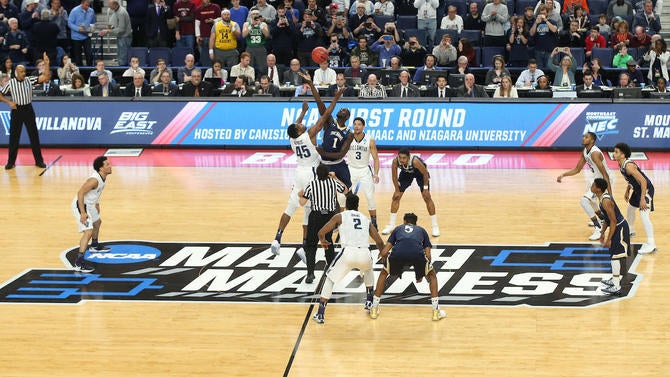
The last time NCAAs had a replacement team
The NCAA recently announced its replacement-team policy, should such a policy need to be enacted this year. While it makes for tempting fodder, I'll remind you that the window for a team to hop into the bracket that isn't part of the field of 68 on Selection Sunday is only 48 hours. It's obviously possible, but seems unlikely. However, if we do have a situation in which one team has to drop out and another joins, it will not be the first time this has happened.
In 1970, Marquette coach Al McGuire was seething at the committee. (Yes, they had one even back then.) However, the tournament didn't have seeding until 1978. So what was McGuire hot over in '70? His region! Marquette was placed into the Midwest portion of the bracket, as opposed to the more-desired Mideast. McGuire refused the NCAA's at-large invitation and took his team to the NIT instead -- and then went on to win that tournament. Dayton was called up as a replacement team. (In 1970 the NCAA Tournament had surpassed the NIT in prestige, but the two were much more 1a and 1b vs. what the NIT has become in the past 30 years.)
A nugget: Marquette beat LSU in the NIT championship game, which was also the final college game of Pete Maravich's career. As for Dayton, it lost its first round game to Houston. So if we do have a team get the call-up next week, just know that this happened 41 years ago. But unlike then, teams are no longer allowed to reject an NCAA Tournament bid to play in the NIT (a choice no one would make now anyway).
@ me
My thanks to readers and followers all season for sending their questions. We'll do it again next year!
Kinda feels like Dayton should be allowed to bring back Obi Toppin for this year’s tourney, right?
— Tim Rychel (@tim_rychel) March 7, 2021
The Flyers have been on my mind as of late. UD fans, I feel for you. Wish we could've had Toppin in the Dance. From No. 1 seed one year ago to a slip back into national irrelevance. As most were saying a year ago, there's no guarantee Dayton gets a 2020-type season again the next three decades. It's a bummer. (Dayton went 14-9 this season.)
Are the teams going to be placed in regions geographically like they would in a normal year, or is geography not going to be a factor since the whole tournament is in Indiana?
— Mark Stouffer (@MarkAStouffer) March 8, 2021
It was announced Monday that the NCAA will keep its four regions named East, West, Midwest and South. As to the Q, this is not yet determined, but my understanding and instinct says no. You will not have an allotment of teams seed on the top four lines in the East all come from the East Coast, nor the South with southern-based schools. Will Gonzaga be No. 1 in the West? I think so. But this isn't going to be something the committee strictly abides by because geography is moot this year.
What happens on Selection Sunday if:
— Mason Shirley (@TheMasonShirley) March 8, 2021
Illinois meets up with Michigan in the B1G title game and Illinois wins, again?
Both still obviously #1 seeds but-- does Illinois jump Michigan in the overall rankings?
If it were up to me, I would jump Illinois over Michigan if this happened. I believe the committee would as well. The only way the teams can meet is in the Big Ten title game. So you'd have an Illinois team that won the most games in the Big Ten in the regular season, then accrued three more Quad 1 wins on its way to having the most Quad 1 wins in the sport with a 2-0 sweep of Michigan in the process. Any argument to place Michigan over Illinois at that point would be a feeble one.
Matt, if the Indy format is successful, do you think the NCAA would ever consider moving to a single city format in the future? Or is the preference to have sites all over the country?
— Dave Singleton (@dfsingleton) March 6, 2021
Good question. There's too much commerce and economical impact -- not to mention how logistically insane trying to host 68 teams in one city is -- for the NCAA to ever intentionally return to the 2021 format. I'm looking forward to experiencing a unique NCAA Tournament, but I know NCAA folks in Indianapolis are eager to host this and then never have to go through something like it again. Cities across the country deserve opportunities to host the NCAA Tournament, and that model will permanently return in 2022.
@MattNorlander Not that anyone needs one, but what’s the reason behind the Blues Traveler avatar?
— PC (@thatswhatPCsaid) March 5, 2021
A non-hoops question. I mix up the ol' Twitter avi every 3-4 months with a new album cover; been doing it for basically almost a decade. Blues Traveler's 1994 classic "Four" also has one of the more memorable cover arts of that decade. While "Run-Around" and "Hook" are the hits everybody knows, "Crash Burn" is the deep cut that shows off how talented the band was at its peak.
Did you ever post the isolated clip of just the intro? Having a hard time finding it.
— Ty Hayes (@TMagTerp) March 7, 2021
Ty is referring to the March 3 episode of Eye on College Basketball. I got a lot of requests to upload it as an isolated piece of audio for future generations to enjoy. So I did just that. Here ya go! Try and dodge the goosebumps. You can't.
Final shots
• Let's start with some coaching-cycle scuttlebutt. You better believe there are schools sending out feelers to people connected to coaches to politely gauge their interest in any potential openings. In talking to various sources in the past week, here's my impression as of today with power-conference gigs that have speculation around them and expectations in the coming days and weeks.
Jobs I've been told are definitely opening: DePaul, Minnesota.
Jobs I've been told are definitely not opening: Marquette, Miami, Notre Dame.
Jobs I've been told will probably not open: Indiana, Kansas State, South Carolina.
Job I've been told is more likely to open than not: Iowa State.
A unique situation no one can predict: Arizona.
• Latest tally on teams to be eliminated from conference tournament play on account of COVID protocols: six. Duke, Charleston Southern, FIU, Holy Cross, Jacksonville and Northern Iowa (which was unfairly disqualified).
• Kansas star David McCormack did not travel with the team to the Big 12 Tournament. Bill Self said he expect McCormack to be available for the NCAA Tournament. How exactly he gets to Indianapolis I'm not quite sure. Remember, the rules is that all Tier 1 personnel have to have seven straight negative tests before they can leave for Indy. We'll see if any other teams are impacted by this in the next 72 hours.
• Ken Pomeroy ran the data and venues with no fans or very few fans did lead to less of a homecourt advantage in 2020-21, but it was drastic. Home teams won 57.5% of league games by an average of 2.45 points. That's the lowest since he's been tracking for two-plus decades, but only slightly lower than 2016-17's numbers of 59.0% and 2.79 points. No fans did make a difference but playing at home still brought an edge.
• As it should be: The WAC voted unanimously to award the late Lew Hill as its coach of the year. Hill died unexpectedly in his sleep in February.
• USA Today published its annual database of the salaries of college basketball coaches. There are 26 coaches who made more than $3 million in the past year and 55 who made more than $2 million. (That number will be going up. Many of the coaches just under $2 million will see pay hikes in their contracts next season.)
• Want more evidence that not having a full season can create "chaos" in league tournaments? The No. 1 seeds in the America East, CAA, Horizon League, MAAC, NEC, OVC, Patriot, Summit League and Sun Belt all failed to make the championship game in their respective brackets. Expect more of that in the next 48 hours.
• Winthrop winning the Big South auto bid saved the selection committee from breaking precedent. Never before has a team with fewer than three losses been snubbed an at-large bid. In fact, teams with just one or two losses not winning an automatic bid is rare. Since 1994, just five teams with one or two losses have received an at-large bid: Kentucky 1996 (28-2); Saint Joseph's 2004 (27-1); George Washington 2006 (26-2); Syracuse 2012 (31-2); Kentucky 2012 (32-2). If it happens this year, Baylor is the only candidate.
• As for at-large teams with poor winning percentages, Georgia was 16-14 in 2001 and remains the (low) bar, as it's the only team in the past 25 tournaments to get in while being fewer than four games above .500. Someone's going to be only two or three games above .500 and get an at-large this year. I can feel it.












